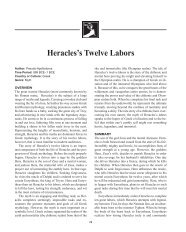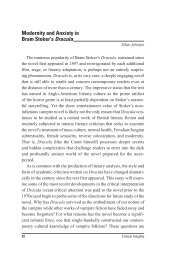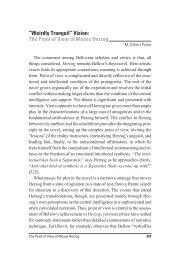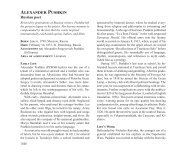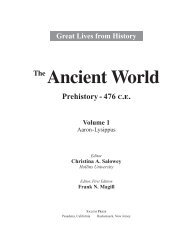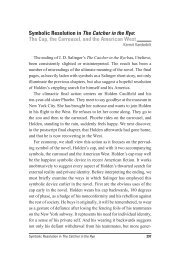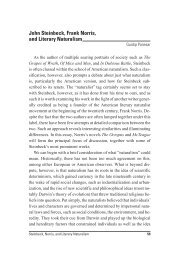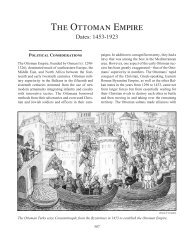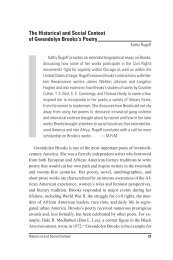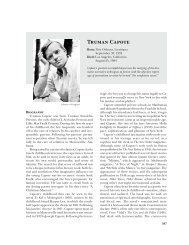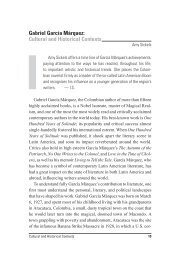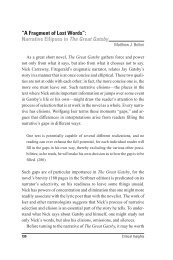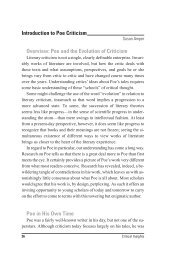Create successful ePaper yourself
Turn your PDF publications into a flip-book with our unique Google optimized e-Paper software.
Critical Survey of Poetry Neihardt, John G.<br />
Indian Tales and Others (1926) are often excellent. His<br />
early novels are less successful, but Black Elk Speaks<br />
(1932) and his last novel, When the Tree Flowered<br />
(1951), are considered masterpieces of the literature on<br />
Native Americans and have been translated into many<br />
languages.<br />
In addition, Neihardt excelled in nonfiction: The<br />
River and I (1910) chronicles his outdoor adventure<br />
down the Missouri River, The Splendid Wayfaring (1920)<br />
provides a history of fur expeditions, and Poetic Values<br />
(1925) outlines Neihardt’s philosophy of poetry developed<br />
during an editorial career of almost forty years.<br />
Achievements<br />
For many, John G. Neihardt is the premier Western<br />
poet; he is also a primary midwestern literary critic and<br />
authority on the Plains Indians. In 1917, he received his<br />
first honorary doctorate from the University of Nebraska,<br />
and his epics were subsequently printed in school<br />
editions to acquaint Nebraska’s students with their heritage.<br />
In 1921, he was celebrated as the poet laureate of<br />
Nebraska; he was awarded the Gold Scroll Medal of<br />
Honor in 1935 and the American Writers Award for Poetry<br />
in 1936.<br />
International recognition came in 1959 in Lindau,<br />
Germany, when Neihardt was made a fellow of the International<br />
Institute of Arts and Letters. He was honored<br />
as the Plains State poet laureate in 1968, and at the time<br />
of his death, there was a bill before Congress to appoint<br />
him poet laureate of the United States. Although he received<br />
all these honors graciously, his goal was to do for<br />
the prairies what Homer had done for Ilium.<br />
Biography<br />
John Gneisenau Neihardt was born January 8, 1881,<br />
in a two-room rented farmhouse near Sharpsburg, Illinois.<br />
Later, his family moved into a one-room sod house<br />
in Kansas. Neihardt grew up on the edge of the frontier,<br />
gathering buffalo chips for fuel, as the great herds had<br />
vanished only a few years earlier.<br />
Two experiences deeply impressed the young Neihardt:<br />
the sight of the Missouri River in flood, and a<br />
fever-induced, mystical dream in which he vividly experienced<br />
flight. These two powerful experiences turned<br />
him toward poetry. He continued to gather raw materials<br />
from his closeness to nature’s beauty and power and<br />
through his lifelong contact with Plains Indians, fur trappers,<br />
migrant workers, and cowboys.<br />
Neihardt went directly from elementary school to<br />
Nebraska Normal School. Then after harvesting beets,<br />
pulling weeds, and teaching in a Nebraska country school,<br />
he set out on a hobo journey to Kansas City, Missouri,<br />
all the while revising his first book of poems, The Divine<br />
Enchantment.<br />
Next Neihardt worked as an editor for the Omaha<br />
Daily News and began to establish a fellowship with the<br />
Omaha Indians, whose tribal chant rhythms are directly<br />
reflected in The Wind God’s Wooing. His collected lyric<br />
poems in A Bundle of Myrrh became an immediate success<br />
and brought him an offer to finance a solo adventure<br />
down the Missouri River in a homemade boat, documented<br />
in The River and I. Also, this volume of poetry<br />
reached New Yorker Mona Martinson, who was studying<br />
sculpture in Paris, and after a brief courtship by mail,<br />
she and Neihardt were married in Oklahoma.<br />
In 1910, Neihardt joined the literary staff of The New<br />
York Times, and he subsequently served as editor for the<br />
Minneapolis Journal, The Kansas City Journal, and The<br />
Saint Louis Post-Dispatch. During his editorial career,<br />
he continued to write, producing several short stories,<br />
four verse plays, and two novels, The Dawn Builder<br />
(1911) and Life’s Lure (1914). In 1932, at thirty-one,<br />
with his reputation secure, Neihardt began work on his<br />
epic, A Cycle of the West. Twenty-nine years later, he<br />
completed this heroic cycle on the adventures of the<br />
American fur trade.<br />
Neihardt’s best friend among the Sioux was Black<br />
Elk, the tribe’s last surviving priest. The poet became the<br />
shaman’s spiritual son and absorbed the Lakota mysticism<br />
which became part of Neihardt’s most popular<br />
prose work, Black Elk Speaks.<br />
In 1942, Neihardt worked in Chicago slums with<br />
street gangs while waiting for a vacancy in the Bureau of<br />
Indian Affairs. In 1948, he purchased Skyrim Farm in<br />
Missouri and became poet in residence at the University<br />
of Missouri, Columbia, teaching literary criticism and a<br />
class called Epic America. When he died at ninety-two,<br />
he was in the process of writing Patterns and Coincidences<br />
(1978), a second volume to his autobiography,<br />
All Is but a Beginning (1972).<br />
2745



